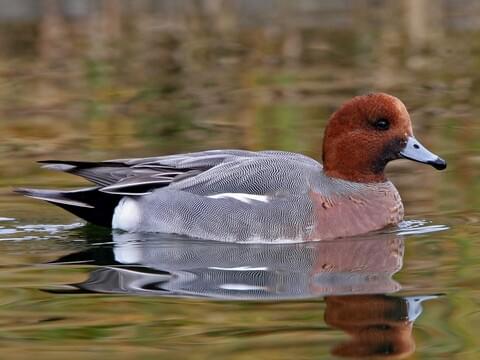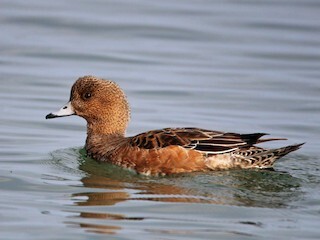Eurasian Wigeon


Scientific Name
Mareca penelope
Alternative Names
Eurasian Wigeon, European Wigeon, Widgeon
Measurements
| Feature | Male | Female |
|---|---|---|
| Length | 42–52 cm (17–20 in) | 42–52 cm (17–20 in) |
| Weight | 500–1,073 g (1–2 lb) | 500–1,073 g (1–2 lb) |
| Wingspan | 71–80 cm (28–31 in) | 71–80 cm (28–31 in) |
Status
A common and widespread dabbling duck across Europe and Asia. Classified as Least Concern under the Agreement on the Conservation of African-Eurasian Migratory Waterbirds (AEWA).
Identification
A medium-sized duck with a rounded head and short bill. The breeding male has a pinkish breast, white belly, gray back and flanks, and a black rear. Its chestnut head is marked by a creamy-yellow crown, and its wings show a striking white patch and dark green speculum. Females are light brown with two common color forms—one rufous and the other grayish. In non-breeding (eclipse) plumage, males look more like females but retain subtle hints of their bright markings.
Voice
Males make a clear, whistling sound like “pjiew pjiew.” Females give a soft growling call that sounds like “rawr.”
Diet
Feeds mainly on aquatic plants, grasses, and roots. Often grazes on land like a goose and sometimes dabbles in shallow water for vegetation.
Distribution
Breeds in northern Europe and across the Palearctic region. During winter, it migrates south to Africa and southern Asia. Common as a winter visitor in Great Britain and Ireland, but breeds only in small numbers in northern parts of the British Isles. Occasionally seen in North America, especially along the Atlantic and Pacific coasts.
Habitat
Prefers open wetlands such as marshes, flooded meadows, and lakes with some tall vegetation nearby. In winter, it can also be found on coastal estuaries and inland reservoirs.
Breeding
Nests are built on the ground near water, hidden under grass or low plants. The female lays and incubates the eggs, while the male may stay nearby for a short time before joining flocks.
Wintering
Highly migratory—spending winters in southern regions where water remains unfrozen. Often seen in large, social flocks that may mix with other duck species.
Conservation
The species is widespread and abundant. Protected under international agreements for migratory waterbirds, and its global population is considered stable.
